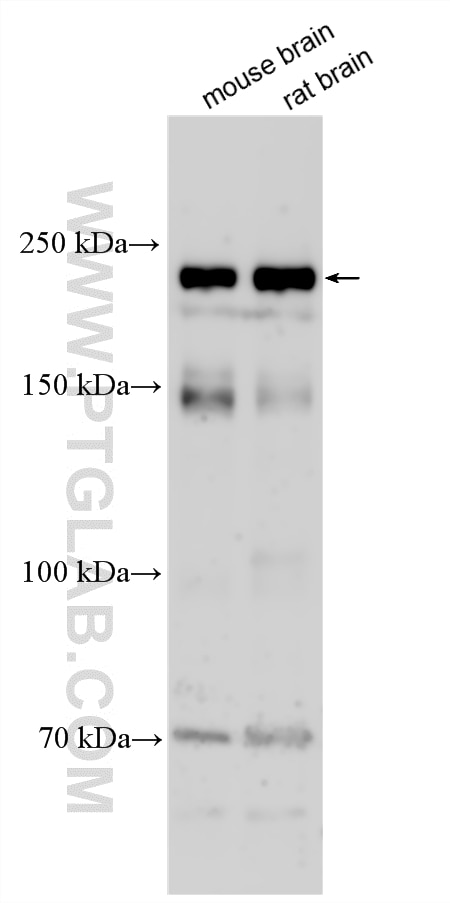PLXNA4 Polyklonaler Antikörper
PLXNA4 Polyklonal Antikörper für WB, ELISA
Wirt / Isotyp
Kaninchen / IgG
Getestete Reaktivität
human, Maus, Ratte
Anwendung
WB, ELISA
Konjugation
Unkonjugiert
Kat-Nr. : 17201-1-AP
Synonyme
Geprüfte Anwendungen
| Erfolgreiche Detektion in WB | Maushirngewebe, Rattenhirngewebe |
Empfohlene Verdünnung
| Anwendung | Verdünnung |
|---|---|
| Western Blot (WB) | WB : 1:1000-1:8000 |
| It is recommended that this reagent should be titrated in each testing system to obtain optimal results. | |
| Sample-dependent, check data in validation data gallery | |
Produktinformation
17201-1-AP bindet in WB, ELISA PLXNA4 und zeigt Reaktivität mit human, Maus, Ratten
| Getestete Reaktivität | human, Maus, Ratte |
| Wirt / Isotyp | Kaninchen / IgG |
| Klonalität | Polyklonal |
| Typ | Antikörper |
| Immunogen | PLXNA4 fusion protein Ag10978 |
| Vollständiger Name | plexin A4 |
| Berechnetes Molekulargewicht | 522aa,58 kDa; 1894aa,212 kDa |
| Beobachtetes Molekulargewicht | 212 kDa |
| GenBank-Zugangsnummer | BC028744 |
| Gene symbol | PLXNA4 |
| Gene ID (NCBI) | 91584 |
| Konjugation | Unkonjugiert |
| Form | Liquid |
| Reinigungsmethode | Antigen-Affinitätsreinigung |
| Lagerungspuffer | PBS with 0.02% sodium azide and 50% glycerol |
| Lagerungsbedingungen | Bei -20°C lagern. Nach dem Versand ein Jahr lang stabil Aliquotieren ist bei -20oC Lagerung nicht notwendig. 20ul Größen enthalten 0,1% BSA. |
Hintergrundinformationen
PLXNA4 is a plexin family receptor that transduces semaphorin signals to regulate axon guidance, vascular development, and immune cell migration. It functions as a plasma membrane receptor with intracellular GTPase-regulatory activity, linking extracellular cues to cytoskeletal remodeling. Dysregulation of PLXNA4 has been associated with neurological disease (including Alzheimer's), cancer progression, and vascular/immune dysfunction, making it a multifunctional receptor of significant biomedical interest. (PMID: 27127761)
Protokolle
| PRODUKTSPEZIFISCHE PROTOKOLLE | |
|---|---|
| WB protocol for PLXNA4 antibody 17201-1-AP | Protokoll herunterladen |
| STANDARD-PROTOKOLLE | |
|---|---|
| Klicken Sie hier, um unsere Standardprotokolle anzuzeigen |


